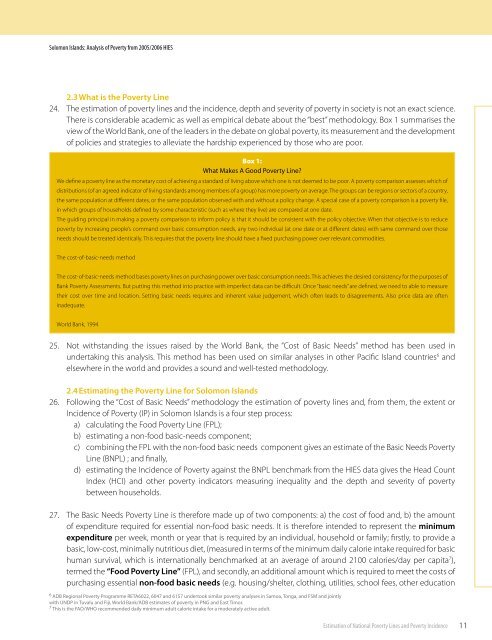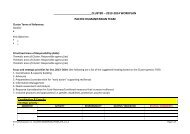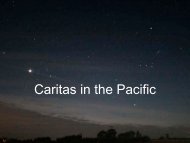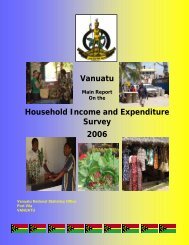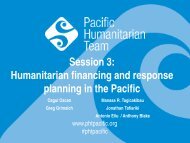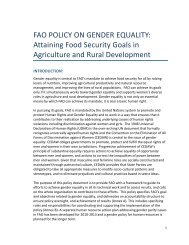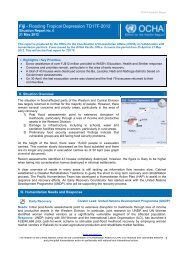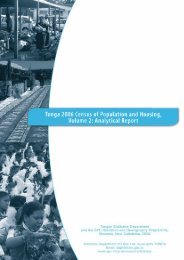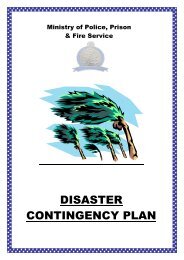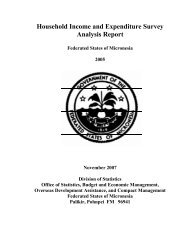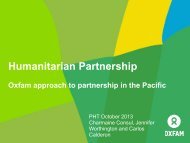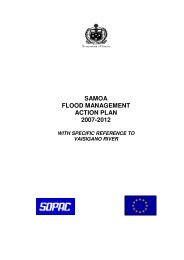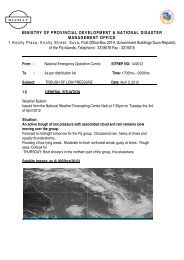Solomon Islands - Asia & the Pacific
Solomon Islands - Asia & the Pacific
Solomon Islands - Asia & the Pacific
Create successful ePaper yourself
Turn your PDF publications into a flip-book with our unique Google optimized e-Paper software.
<strong>Solomon</strong> <strong>Islands</strong>: Analysis of Poverty from 2005/2006 HIES2.3 What is <strong>the</strong> Poverty Line24. The estimation of poverty lines and <strong>the</strong> incidence, depth and severity of poverty in society is not an exact science.There is considerable academic as well as empirical debate about <strong>the</strong> “best” methodology. Box 1 summarises <strong>the</strong>view of <strong>the</strong> World Bank, one of <strong>the</strong> leaders in <strong>the</strong> debate on global poverty, its measurement and <strong>the</strong> developmentof policies and strategies to alleviate <strong>the</strong> hardship experienced by those who are poor.Box 1:What Makes A Good Poverty Line?We define a poverty line as <strong>the</strong> monetary cost of achieving a standard of living above which one is not deemed to be poor. A poverty comparison assesses which ofdistributions (of an agreed indicator of living standards among members of a group) has more poverty on average. The groups can be regions or sectors of a country,<strong>the</strong> same population at different dates, or <strong>the</strong> same population observed with and without a policy change. A special case of a poverty comparison is a poverty file,in which groups of households defined by some characteristic (such as where <strong>the</strong>y live) are compared at one date.The guiding principal in making a poverty comparison to inform policy is that it should be consistent with <strong>the</strong> policy objective. When that objective is to reducepoverty by increasing people’s command over basic consumption needs, any two individual (at one date or at different dates) with same command over thoseneeds should be treated identically. This requires that <strong>the</strong> poverty line should have a fixed purchasing power over relevant commodities.The cost-of-basic-needs methodThe cost-of-basic-needs method bases poverty lines on purchasing power over basic consumption needs. This achieves <strong>the</strong> desired consistency for <strong>the</strong> purposes ofBank Poverty Assessments. But putting this method into practice with imperfect data can be difficult. Once “basic needs” are defined, we need to able to measure<strong>the</strong>ir cost over time and location. Setting basic needs requires and inherent value judgement, which often leads to disagreements. Also price data are ofteninadequate.World Bank, 199425. Not withstanding <strong>the</strong> issues raised by <strong>the</strong> World Bank, <strong>the</strong> “Cost of Basic Needs” method has been used inundertaking this analysis. This method has been used on similar analyses in o<strong>the</strong>r <strong>Pacific</strong> Island countries 6 andelsewhere in <strong>the</strong> world and provides a sound and well-tested methodology.2.4 Estimating <strong>the</strong> Poverty Line for <strong>Solomon</strong> <strong>Islands</strong>26. Following <strong>the</strong> “Cost of Basic Needs” methodology <strong>the</strong> estimation of poverty lines and, from <strong>the</strong>m, <strong>the</strong> extent orIncidence of Poverty (IP) in <strong>Solomon</strong> <strong>Islands</strong> is a four step process:a) calculating <strong>the</strong> Food Poverty Line (FPL);b) estimating a non-food basic-needs component;c) combining <strong>the</strong> FPL with <strong>the</strong> non-food basic needs component gives an estimate of <strong>the</strong> Basic Needs PovertyLine (BNPL) ; and finally,d) estimating <strong>the</strong> Incidence of Poverty against <strong>the</strong> BNPL benchmark from <strong>the</strong> HIES data gives <strong>the</strong> Head CountIndex (HCI) and o<strong>the</strong>r poverty indicators measuring inequality and <strong>the</strong> depth and severity of povertybetween households.27. The Basic Needs Poverty Line is <strong>the</strong>refore made up of two components: a) <strong>the</strong> cost of food and, b) <strong>the</strong> amountof expenditure required for essential non-food basic needs. It is <strong>the</strong>refore intended to represent <strong>the</strong> minimumexpenditure per week, month or year that is required by an individual, household or family; firstly, to provide abasic, low-cost, minimally nutritious diet, (measured in terms of <strong>the</strong> minimum daily calorie intake required for basichuman survival, which is internationally benchmarked at an average of around 2100 calories/day per capita 7 ),termed <strong>the</strong> “Food Poverty Line” (FPL), and secondly, an additional amount which is required to meet <strong>the</strong> costs ofpurchasing essential non-food basic needs (e.g. housing/shelter, clothing, utilities, school fees, o<strong>the</strong>r education6 ADB Regional Poverty Programme RETA6022, 6047 and 6157 undertook similar poverty analyses in Samoa, Tonga, and FSM and jointlywith UNDP in Tuvalu and Fiji, World Bank/ADB estimates of poverty in PNG and East Timor.7 This is <strong>the</strong> FAO/WHO recommended daily minimum adult calorie intake for a moderately active adult.Estimation of National Poverty Lines and Poverty Incidence11


